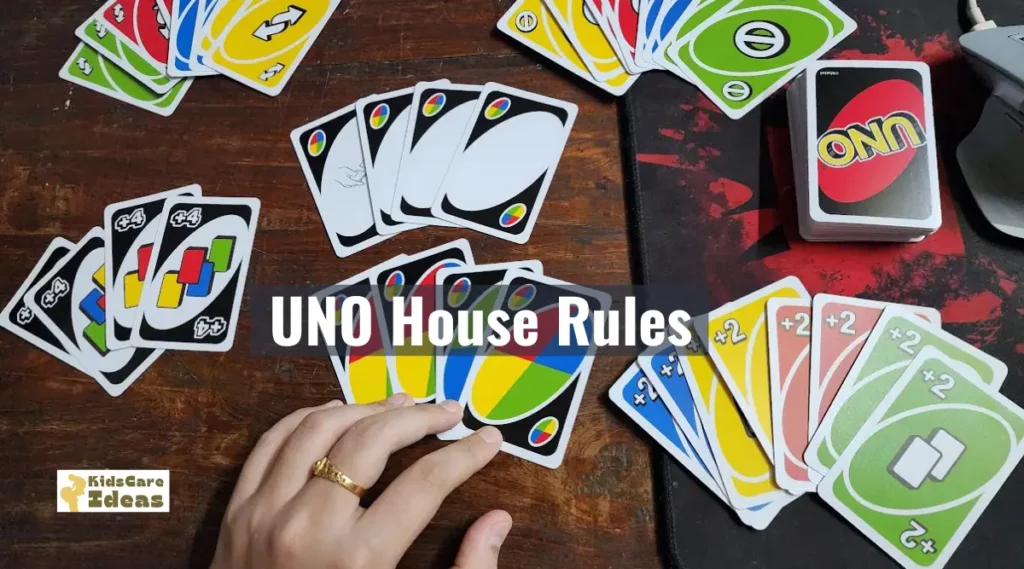
Knowing the Uno House Rules
Jump in UNO
In this version, if a player has the same card in their hand as the top card of the discard pile, they can assume complete control of the game.
Wess Eslinger introduced this rule into his games, and then Mattel declared that this one was the best house rule ever.
Seven-O UNO
The version which was placed in the second-best rank was devised by Sarah Petite. This version includes passing hands to other players in the game while playing some specific cards.
Progressive UNO or Stacking UNO
When a player plays the draw card, a victim has to bear the consequences of a player drawing the draw card. This is usually the immediate next player.
If the victim can play a similar card, they can dodge, facing the consequences themselves, and pass it to the next player. This version was introduced by Douglas Temple.
Hot Death UNO
This one is a crooked version of Uno and involves plenty of bizarre new and exciting rules. The first of which is placing 27 extra cards in the gameplay. The game allows players to draw up to 69 cards at a go and display the cards at once. It is fun, exciting, and out of the box.
What does House Rule Mean in UNO?
When Uno was popularized in the market by Mattel, the company accompanied a card pack with instructions. This instruction contains some rules known as the official rules of Uno.
However, with advancing time and the game’s growing popularity, the players introduced rules into each game, making it more adaptable for themselves. These unique and unofficial rules the players introduced are called House Rules.
Things you need to Play
There is nothing new that you need to play the Uno house rules. All you need is the regular deck of Uno cards, the dealer, and 2 to 10 players to play the game. If you decide on any new genre of house rules, ensure that all the players agree to it before playing. That is all.
Scoring Uno House Rules
Scoring in Uno House Rules usually continues in the same way as for Uno classic. That is, the numbered cards will all be worth their face value.
For the other cards, the values differ from the classic version depending on the type of rules that you weave around it. Sometimes, the house rules specify differential scoring based on a particular color suit or the card numbers.
There is no unique rule regarding the gameplay when playing Uno House Rules. As in Uno classic, the primary game objective is to eliminate all the cards at hand before any other player.
The winner can also be determined based on who touches the 500 marks score before others. The players must shout out Uno when playing their penultimate card. Otherwise, they can get penalized.
There will be a dealer of the game who will shuffle and assign the card to the players. The gameplay usually starts from the immediate left of the player and continues in an anti-clockwise direction unless a reverse card is played.
The scores can be calculated at the end of each round or the ultimate end, there has to be a suitable scorekeeper tallying the scores of the individual players. The numbered cards are worth their face value.
The action and wild cards are worth differential points, and several types of cations can be possible. They make the game more fun and exciting to play.
UNO House Rules Example with Gameplay
Even when playing by following the House Rules of UNO, the primary idea is the same as that of Classic Uno: to get rid of all the cards before any other player or reach the 500 points mark.
And just as in the classic Uno game, the player must scream aloud Uno when they are playing the penultimate card otherwise, the player will be handed over 2 extra cards that they need to play with. The discarding and drawing card concepts are almost similar – matching colors or numbers.
Before playing the Uno House Rules, it is recommended that the players get familiar with the basic rules of Uno. This helps in a better understanding of the game.
Let us study an example of an Uno House Rule with the gameplay:
In this specific house rule play, the actions start before the first player plays their first card. The game’s dealer will start shuffling the cards and handing them to the players. But the dealer of the cards must rotate between every hand.
This rule is strictly reinforced because the house rule says that if the dealer pulls out the number of cards to be dealt to all the players in a single deck cut before dealing the cards, the dealer will suffer 50 points cut from whatever they achieve.
Fifty points may not seem a vast number right at the beginning, but toward the end, even a 50 points difference can change the game’s course.
- The next twist comes up with the Wild Uno Rules, which undoubtedly is the funniest and most exciting part of the house rules. Before moving into this, let’s explore the actual differences between classic Uno and Uno house rules are:
- In Uno House rules, the players can play out of turn, whereas in Uno classic, they cannot
- Uno House rules at times allow for stacking cards but with consequences. Stacking can be introduced as a part of the house rules, and the players can pertain to it. In Uno classic, stacking is strictly forbidden
- Uno House rules allow zero hand swaps and red zero of death, both of which are unavailable for the Uno Classic version.
- Playing Out of Turn: In the classic game of Uno, every player has to wait for their turn. This means the game starts from the dealer and now revolves across specific directions. In this way, every player gets a turn to play their cards and has to wait till they get their turn again. In this house rule, the players can even play when it is not their turn. When a player realizes that a card in their hand resembles the just played card, they can skip the other player’s turns and match the card. To use this rule, the card in your hand should be an exact match of the card just played, only then can you cut through the player’s turn in line and play your card. Exact means for the regular ards the smee color and number and for the wild or cartoon cards, the exact same card.
- Stacking Cards: The one house rule that almost every player is thrilled to explore is the stacking cards. Stacking cards is strictly forbidden in Uno. But you can always introduce the rule as the house rule of the game. The basic norm around it is that if a player plays two identical action cards just one after the other, the action is doubled. For example, if any player plays a green draw 2 cards and another player skips the usual turn of the game to play precisely similar another green 2 cards, the player next in turn, as per the usual gameplay direction, will have to draw 4 cards. That is how it goes.
- Handling the Zero: This one is truly a trick, especially regarding house rules. Zero in the classic Uno game will not add points to your score. In the Uno house rules, when a player plates the zero card, all the other players must show their hand to the player next to them in the usual game direction. If the game is moving in a clockwise direction, and a zero card is played, you now have to hand over your cards to the player on your immediate left and receive cards from the player on your right. This is truly mind-boggling and can shuffle the entire game course.
The most dangerous card in the Uno house of rules is probably the Red Zero of Death. If you are already startled by the zero rule of the game, it is time to explore the Red Zero death, which is an even more dangerous and powerful house rule.
If any Uno player lays down the red zero card, the player will add 10 cards to their hand. Yes, you heard that right – 10 cards at a go and then passed it to the next player in the usual game direction. They can see which cards they pass to the next player when they add the cards.
Usually, the next player, that is, the one who has been handed the cards, plays a zero to get rid of the cards at once immediately. This places the game in an unpredictable domain. You truly never know when a player will use the red zero card or when you have to
In this House rule version of Uno, the scoring is s bit different. Get this clear, if you are framing Uno house rules by yourself, you can also devise a unique scoring mechanism. However, the end goal should be whoever scores 500 points before other players win the game.
But, the scoring pattern can be unique. Usually, players don’t drift from the ordinary scoring course – that is the face value for the numbered cards. A significant scoring difference is observed in the zeros. Zeros in the Uno House Rules version are not worth their face value.
The blue, green, and yellow zeros will fetch 20 points and action cards like Draw 2 and Wild cards. The red zero of death will bring 50 points.
The rules often vary among several countries. For example, one of Sweden’s most famous house rules is the freedom to play several cards at once on your turn.
For example, if the last card in the discard pile is a blue 5, and you have a red 5 and a green 5, you could effectively play them together, laying them consecutively. That makes it so much more enjoyable.
If you decide on any other scoring rules, ensure that all the players agree.
The pro tip for playing and winning the Uno House Rules game is to be competitive. Since some of the rules can get bizarre and wild, and it will turn into aggressive gameplay, it is impossible to win the game or be in good game shape if you don’t have the zeal for competition.
Sticking to the rules, fair and boring play hardly does any good in the Uno House Rules version. The unique cards of Uno are maximally used to enhance the fun and wildness of the game. Since there is little scope to fiddle with the numbered cards, the rules change, and the crazy elements are all included in the wild and action cards.
Is stacking in UNO a House rule?
Stacking is not an official rule in Uno. No players can stack cards if they stick to the official rules of the Uno classic introduced by Mattel. However, some players may decide upon stacking as the house rule and introduce the same in the game.
What’s Next?
Learn About the UNO Rules and Gameplay. Here are the different Official UNO Rules and rules for each of the components in the game:
- UNO Draw 4 Rules
- UNO Draw 2 Rules
- UNO Wild Card Rules
- UNO Reverse Card Rules
- UNO Skip Card Rules
- UNO Last Card Rule
- UNO Swap Hands Card Rules
- UNO Blank Wild card Rules
- Custom UNO Card Ideas
- UNO Shuffle Hands Card Rules
- UNO Stacking Rules
Also, read about How to Cheat At UNO?
